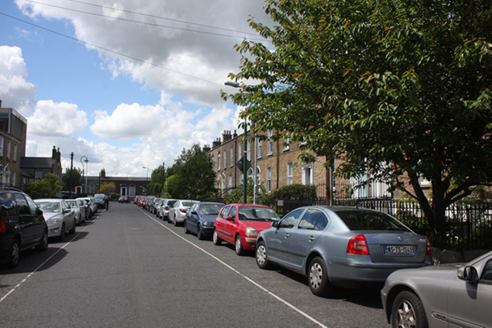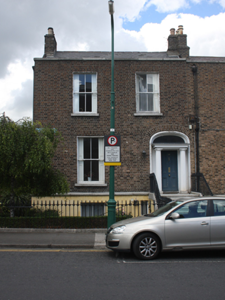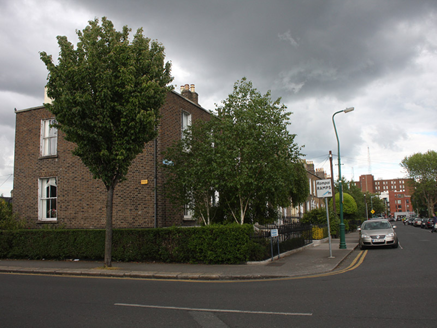Survey Data
Reg No
50110342
Rating
Regional
Categories of Special Interest
Architectural, Artistic
Original Use
House
In Use As
House
Date
1845 - 1865
Coordinates
315407, 232916
Date Recorded
11/05/2017
Date Updated
--/--/--
Description
Corner-sited end-of-terrace two-bay two-storey house over raised basement, built c. 1855, as one of terrace of eleven. Return to rear. Pitched slate roof, hipped to west to rear, with brick and rendered chimneystacks having terracotta pots, partly concealed behind parapet with cut granite coping to front (south) and side (west) elevations. Brown brick, laid in Flemish bond, to walls with cut granite plinth course over lined-and-ruled rendered basement wall. Lined-and-ruled rendered wall to rear. Square-headed window openings having granite sills and raised rendered reveals, having two-over-two pane, one-over-one pane, and six-over-six pane timber sliding sash windows. Timber panelled shutters visible to interior. Elliptical-headed door opening to front elevation, with moulded render surround. Timber doorcase comprising fluted Doric columns supporting dentillated cornice, plain fanlight. Timber panelled door having brass details. Nosed granite steps with cast-iron boot-scrapes to platform and cast-iron railings. Square-headed door opening having timber door to basement. Cast-iron gate and matching railings on granite plinth wall enclosing basement, west elevation of house and yard to rear. Cast-iron gate to rear yard flanked by rendered piers with carved pyramidal granite caps.
Appraisal
A well-proportioned house retaining historic features including a well-executed doorcase and timber sliding sash windows. Its fine railings are testament to the quality of Victorian mass-produced ironwork, and add to both the setting of the house and the character to the streetscape. Built for the growing middle class, its classically-influenced style denoted respectability. Up to the early 1840s the area that now comprises Grantham Street was still largely greenfield. However suburb development soon followed, and P. Monks was building on the street in the late 1850s. In 1862, Thom's Almanac noted that a number of houses were still being built on the street at the time. It also listed a broad range of residents including a professor of music, secretary of Army Medical Board, toothbrush maker, manufacturer, and curate.





